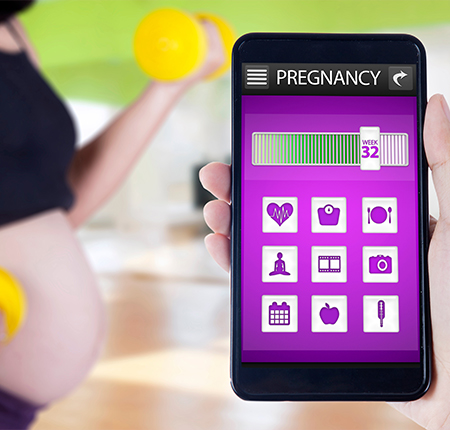
What if as soon as you were confirmed pregnant, you could look into the future and already know when you will bring your baby into the world? The good news is that you don't need a crystal ball, and you don't need an overflowing intuition. Today, you can easily estimate and find out in seconds when you will begin your wonderful journey of motherhood, using a pregnancy calculator.
And no, there is nothing mystical about a pregnancy calculator, just some basic calculations. Because unlike tea leaves or other magical objects, such a calculator is based on concrete information. The tool automatically calculates your pregnancy by weeks and months based on tangible data about your menstrual cycle.
Find out in this article why a pregnancy calculator is useful, how accurate it is and how it works. And if you are pregnant and anxious to know how your pregnancy will progress by weeks, fill in the necessary fields in our calculator below to estimate your baby's due date.
Why a weeks/months pregnancy calculator is useful and what information it gives you
The main role of the pregnancy calculator is to help you calculate the estimated date when the baby will be born. We say estimated date because every pregnancy is unique and develops differently, and all calculated dates are a probability, not a certainty.
It is possible that the birth will take place earlier or later than the calculated date. But it's helpful to use the calculator to at least get a rough idea of how the pregnancy will go. More specifically, the load calculation can give you indicative information about:
The date the pregnancy started
When is the first ultrasound recommended?
When you can find out the sex of the baby, if you want to
The dates on which the first and second trimesters of pregnancy will end
The time when the birth is most likely to occur

Data used by the load calculator
To provide you with a pregnancy calendar and calculate your due date as accurately as possible, the tool uses concrete information about your menstrual cycle. This is precisely why the accuracy of the calculations is more improbable for women who have an irregular cycle.
The information used may differ depending on how the calculator is built, but most of the time you need to know the date of your last period. Most computers use the following benchmarks:
- The first day of your last period
The length of your menstrual cycle
The information provided by the pregnancy calculator
Also, depending on how the pregnancy calculator is programmed, it can give you several types of information.
Some calculators are simpler. They only tell you the approximate date you got pregnant, and the estimated time you are due to deliver the baby.
More complex computers can give you a more complex picture of everything that will happen during pregnancy, namely:
- Reference data : the date on which you became pregnant, the date on which the first and second trimesters will end, respectively the date of the child's birth can be calculated
- Data about the progress of the pregnancy : the calculator can give you a calendar of the pregnancy by weeks or months, it can tell you what week of pregnancy you are in and it can give you indications about when to do the first ultrasound and when you can find out the sex of the fetus
- Information about the development of the baby : by determining what week of pregnancy you are in, there are calculators that also estimate the length and weight of the baby.

Probable date of birth
Theoretically, the birth takes place approximately 38 weeks from the date of conception, respectively 40 weeks from the last period. After these data will make the estimates and the load calculator.
Keep in mind, however, that less than 4% of births occur exactly on the estimated date according to statistics, and for almost 90% of pregnancies there is a difference of about 2 weeks between the calculated date and the actual date of birth. It is equally normal for the baby to be born anytime between 37 and 42 weeks.
So the moment of birth can only be approximated, but it is impossible to predict exactly.
How to calculate the child's date of birth
The calculation process for the date of birth is simple: starting from the first day of the last period, add 280 days (equivalent to 40 weeks). For example, if your last period started on March 1st, add 280 days and get your estimated date of birth on December 8th. You get the same result with another calculation method, i.e. subtract 3 months from the date of your last period, then add another 7 days. One of these two calculation methods is the one used by the calculator to estimate the date of birth.
You can get more accurate results only with the help of the doctor, who will take into account the size of the amniotic sac and the fetus during ultrasounds to determine the age of the pregnancy. But even then, the calculations are estimates, and the birth will occur when the baby is ready.
Why it is useful to estimate the date of birth of the child
For you as a mother-to-be, it is important to know your date of birth in the first place in order to be physically, mentally and emotionally prepared for the motherhood you are about to begin.
It is also important that your doctor estimates the date of birth so that he can perform each analysis on time and, if the term is exceeded, know when it is necessary to induce labor.
Recommendations for using a pregnancy calculator
Fortunately, you no longer have to sit with the calendar in front of you and count the weeks and days yourself, adding and subtracting according to the calculation methods explained above, to approximate the date of birth.
Today, there are online tools that do the calculations automatically for you, such as the pregnancy calculator on our page. All you need to do is know when your first period started and it will show you the likely information about your pregnancy.
Accuracy of the load calculator
It is important to know that what the calculator shows is not the letter of the law, and there are several reasons why these calculations can be inaccurate.
First, the unique course of your pregnancy and the factors that influence it matter a lot. how old are you If you have been pregnant before, how long were the other pregnancies? What is your weight when you are due to give birth? All these things can influence the date of birth.
Equally, the accuracy of the calculated data depends directly on the correctness of the information you fill in. If you do not know the exact date of your last period, or if you have an irregular menstrual cycle, it is possible to enter incorrect data into the calculator, and the results will also be ambiguous. In this case, the doctor can best estimate the date of birth after an ultrasound.
Establishing the months of pregnancy
Based on the calculations performed, the calculator can delimit your three trimesters of pregnancy. It can show you when and how long each month of pregnancy lasts, starting from the 1st month to the 9th month.
Determination of pregnancy weeks
Once the months of pregnancy are determined, it is easy to estimate the weeks as well. When you know what week you are in, you can also get an idea of where your baby is at, as well as what symptoms and changes to expect. I told in much more detail about the development of the baby and the pregnancy by weeks HERE .
Although the birth will theoretically take place at 40 weeks, the baby can come into the world anytime between 37 and 42 weeks.
Pregnancy calculator FAQs
Still confused about the pregnancy calculator? Read the answers to the most frequently asked questions below.
How is the estimated date of birth calculated?
To be able to estimate the date of birth with the help of a calculator, you need to know the date of your most recent period. The day the baby is theoretically due is obtained by adding 280 days to day 1 of your last period.
How accurate is the data provided by the pregnancy calculator?
The accuracy of the information generated by the pregnancy calculator depends on the correctness of the data you have entered. If you have not written the date of your last period correctly or if you have an irregular cycle, the results of the calculations will probably be less accurate. Also, these calculations are only theoretical and indicative - each task has its own rate of development and its own evolution.
What other alternative methods can I use to calculate my pregnancy?
Calculating the pregnancy can also be done according to the date of conception, but it is a method used much less often - because how many women know exactly when the conception took place? But assuming you know the exact date, you can calculate your gestational age as the difference between the current date and the date of conception.
But the most accurate method of calculating the pregnancy remains with the help of the doctor, through ultrasound, according to the size of the amniotic sac and the fetus.
When is it recommended to take a pregnancy test?
Normally, tests can confirm pregnancy a week after your period is late. By then, the concentration of HCG will be high enough to be detected in the urine, indicating that the egg has been fertilized.
However, there are ultra-sensitive pregnancy tests that are much more accurate and can be done even before your period is late. So read the directions on the test packaging, as each test states when it is recommended to take it.
Enroush maternity and maternity products
If the birth will take place on the expected date or will take you by surprise, you will find out at the right time. What you know for sure right now is that throughout your pregnancy and labor, you will want to give your body the most gentle and safe care, for the safety of you and your baby.
Discharges are normal during pregnancy, and in the postpartum period lochia follows, those vaginal bleedings that start profusely and will gradually decrease. So it's a good idea to stock up now on safe intimate care products like Enroush pads made from 100% organic cotton and natural fibers. They do not contain any other toxic ingredients, so they will not cause inflammation and make this period as comfortable as possible.
In addition, you can choose from 3 sizes with different levels of super absorbency, depending on your needs. For the first days postpartum, when lochia is abundant, you need the highest level of absorbency to catch all the blood, which organic night pads can provide. Then, as the bleeding eases, you can move on to super , regular , and finally organic daily pads to protect against leaks.

Hygiene is just as important in the postpartum period, when your vagina is still recovering and more vulnerable to infection. That's why Enroush intimate gel contains 95% natural ingredients with antibacterial and antifungal properties, to gently clean your vulva from the outside and increase skin immunity.
And for those times when you need a quick clean, biodegradable intimate wipes give you freshness with a single touch. Infused with chamomile, prebiotics and lactic acid, they protect intimate flora and remove bacteria and unpleasant odors, so you can feel good in your own skin and focus on your new role as a mom.






















